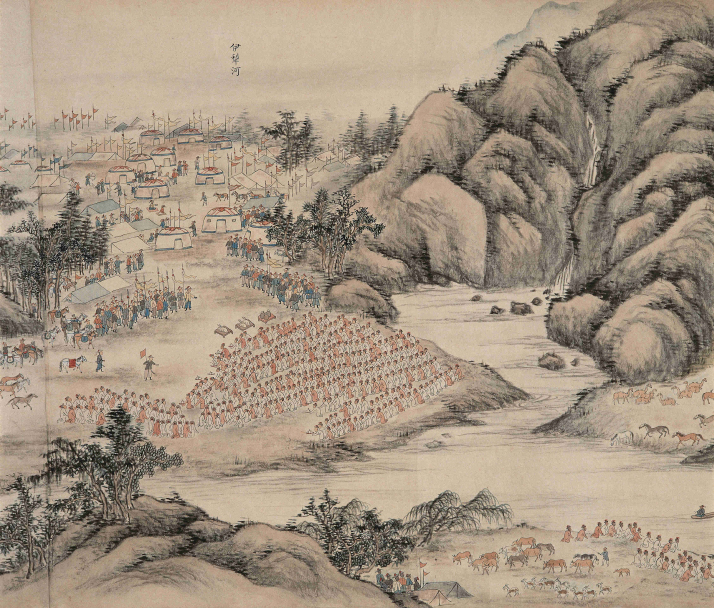| Xinjiang Today |
| A historical chronicle in ink | |
|
|
 A section of Qian Weicheng's 1755 painting, The Scroll of the Pacification of the Junggar, housed in the National Museum of China (NATIONAL MUSEUM OF CHINA)
The Scroll of the Pacification of the Junggar is a powerful historical record, painted by the celebrated Qing court artist Qian Weicheng in 1755, during the 20th year of the reign of Emperor Qianlong. Qian was a truly exceptional figure among the brilliant painters of the Qianlong era. Despite his distinguished bureaucratic career, holding prominent positions such as vice minister of works and vice minister of justice, Qian's true passion lay in painting, a field in which he eventually became a recognized leader. His unusual blend of scholarly achievement and artistic prowess makes his work particularly significant today. The scroll is composed of three distinct parts: The Hard-Fought Battle, The Defeat of Dawachi's Troops and The Celebration of the Victory. It serves as a large-scale visual documentary, chronicling a nearly 70-year-long struggle against separatist forces, a conflict that spanned the reigns of three emperors: Kangxi, Yongzheng and Qianlong. A struggle against separatism In the early Qing Dynasty (1644-1911), Mongolia was divided into three regions, to the north, south and west of the Gobi Desert. The four tribes in the western region (roughly equivalent to modern-day Xinjiang and part of Central Asia), namely the Junggar, the Khoshut, the Dorbet and the Torgut, paid tribute to the Qing government. Later, Galdan Boshugtu Khan, a Mongolian leader, seized power over the Junggar and began to expand his territory. In alliance with Tsarist Russia, Galdan expanded eastward, coming into direct conflict with the Qing government. In response to this threat, Emperor Kangxi led three military campaigns. In 1690, the 29th year of his reign, he defeated Galdan's forces at the Battle of Ulan Butung. Five years later, Galdan led 30,000 cavalrymen eastward. Emperor Kangxi directed the Battle of Jao Modo, and the Qing troops routed Galdan's army. The third expedition in 1697 ultimately led to Galdan's death when, facing utter defeat and abandoned by his followers, he took his own life. The conflict did not end with Galdan's death. Following the passing of Emperor Kangxi, his successor, Emperor Yongzheng, continued the fight against Junggar separatist forces. In winter of 1727, Galdan Tseren, the grand-nephew of Galdan Boshugtu Khan, ascended to the throne and, with the support of Tsarist Russia, renewed the insurrection. In response, Emperor Yongzheng launched four military expeditions to the west. A pivotal victory was the Battle of Khoton-nor in 1731, where Qing troops wiped out a significant Junggar force. The final chapter of the long-running conflict unfolded under Emperor Qianlong. The death of Galdan Tseren in 1745 plunged the Junggar into a fierce power struggle. Emperor Qianlong acted decisively. In 1755, Qing forces launched a two-pronged attack that swiftly defeated the troops of Dawachi, the last major Junggar leader. In 1757, Emperor Qianlong dispatched troops for a final western expedition, completing the pacification of the region. The successful campaigns stabilized and consolidated the Qing's territory. To celebrate this victory and to signify the region's renewed allegiance, Emperor Qianlong named the territory "Xinjiang," meaning "land newly returned." In 60 B.C., Xinjiang, then known as the Western Regions, came under the administration of the Han Dynasty (206 B.C.-A.D. 220). It has since been part of China's territory, but it was not officially a province with that name until 1884. Art and beyond The Scroll of the Pacification of the Junggar, measuring 808 cm in length and 41 cm in width, depicts the Qing army's 1754 campaign against Dawachi, especially the scene of the surrender of thousands. The painting's only combat scene shows Ayusi, an officer of the Qing Dynasty, leading 22 horsemen in a nighttime raid on Dawachi's camp. The scroll also includes a particularly moving scene of local ethnic groups offering food and drink to the Qing soldiers, a gesture of support. The scroll's immense value is underscored by the presence of several imperial seals. These seals confirm that the scroll was part of Emperor Qianlong's personal collection and reflect his deep appreciation and treasured ownership of this historically significant artwork. Liu Wenpeng, a professor with the Institute of Qing History at Renmin University of China, wrote in an article in Lifeweek magazine in 2018 that he believes that the Qing's military campaigns to pacify the Junggar tribes were crucial for the formation of modern China's borders and significant from a global historical perspective. He said during a period when European powers like Britain, France and Tsarist Russia were expanding globally with advanced military technology, had China failed to unify these territories, the expanding Tsarist Russia might have seized them. Comments to maxiaowen@cicgamericas.com |
|
||||||||||||||||||||||||||||
|